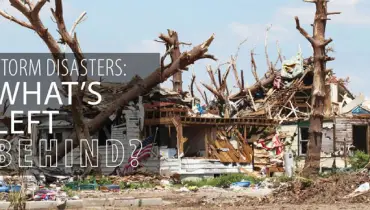
Storm disasters often cause hidden damage that can go unnoticed without expert assessment. Rainbow Restoration highlights some key areas to watch for after severe weather:
|
Storms and other disasters don’t just cause physical damage, they introduce contaminants that can harm your family’s health. That’s why it’s important to clean up and restore what’s left behind following a natural disaster. How do you do that?
Contact Your Insurance Company
Before you begin any restoration, document the hail damage with photos and videos to show your insurance agent. Having complete records will help you get the most from your insurance claim, which you can put toward professional restoration efforts and replacing destroyed belongings.
Dry Out Building Materials
Shovel out as much mud as possible, and then rinse hard surfaces with a garden hose. Scrub walls and other hard surfaces with heavy-duty cleaner and hot water. A solution of 1/4 cup chlorine bleach per gallon of water is an effective disinfectant for killing harmful germs.
Run fans and a dehumidifier to help remove moisture from the air. Opening windows also help to ventilate the space. The goal is to dry out building materials within 24 to 48 hours of the storm disaster to prevent mold growth.
Remove Household Items
Carry household items outside as soon as possible. Throw away mattresses, stuffed animals, bedding, rugs, clothing, and furniture that have been completely saturated by flood water. Wood veneered furniture usually isn’t worth the effort to restore, though solid wood furniture probably is. Leave the restoration of any salvageable items to a professional.
Wash mud from photographs, books, and important documents. Place them in plastic bags and put them in a freezer to prevent mildew growth until you have time to thaw, clean, and dry them properly.
Restore the Kitchen
Clean cupboards and countertops with chlorine bleach. Soak glassware, china, porcelain, and enamelware in a solution of 2 tablespoons of chlorine bleach per gallon of hot water. Disinfect silverware, pots, pans, and other metal items by boiling them in water for 10 minutes. Avoid using bleach in this case because it can react with metal and cause darkening.
Restore the Floor
Remove floor coverings (carpet, vinyl, linoleum) so the subflooring beneath can dry. Throw away carpet and padding that has been under water for more than 24 hours or contaminated by sewage. Otherwise, clean it with disinfecting carpet cleaner. Clean and dry hardwood floors completely before attempting water damage repairs.
Restore the Ceilings and Walls
Since wallboard can act like a sponge, you should remove it along with plaster and paneling. You may be able to salvage these if they weren’t contaminated with sewer water.
Address wall insulation based on the type you have installed. Hose off Styrofoam before putting it back in service, thoroughly dry fiberglass batts before reusing them, and replace blown-in or loose-fill insulation.
Restore the Electrical System and Appliances
To prevent electrocution, shut off everything in the breaker panel until your house is thoroughly dried out. Have the system inspected and repaired if necessary by an electrician before attempting to use any electrical devices.
Appliances and electronics that have been exposed to flood waters must be serviced, cleaned, and sanitized before being put back into service, assuming they’re still functional. The heating and cooling system and ductwork should be cleaned and inspected before being used.
If you’re dealing with property damage after a storm disaster, don’t attempt cleanup yourself. The best results come from relying on a professional remediation company. For water damage cleanup, mold remediation or other restoration services, please contact Rainbow Restoration®. We help with the recovery process so you can get back on your feet.
